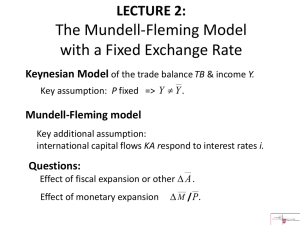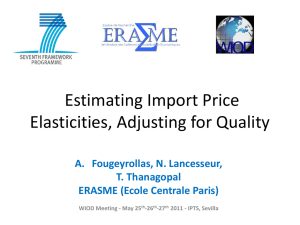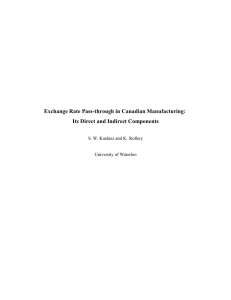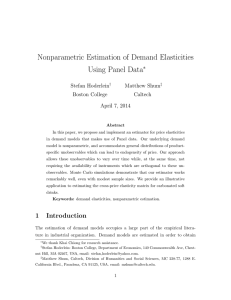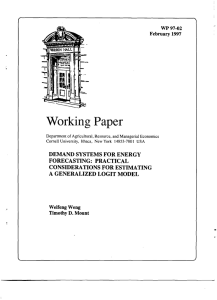L2 - Harvard Kennedy School
advertisement
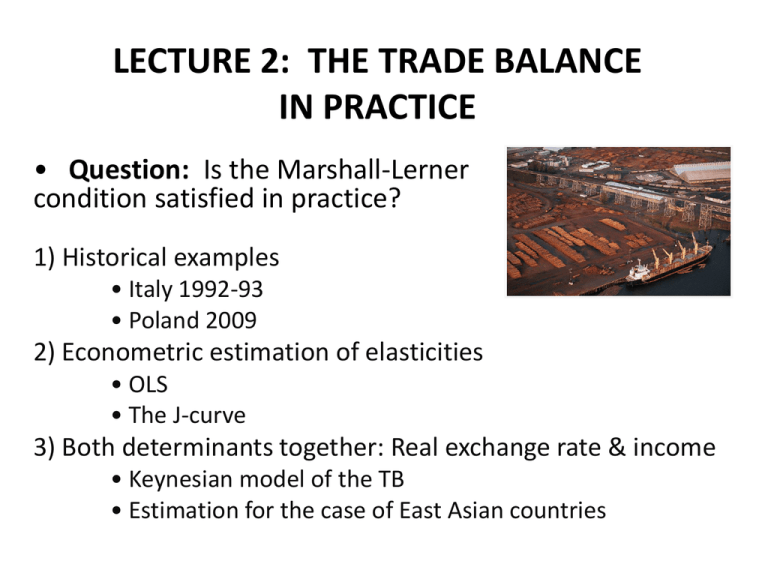
LECTURE 2: THE TRADE BALANCE IN PRACTICE • Question: Is the Marshall-Lerner condition satisfied in practice? 1) Historical examples • Italy 1992-93 • Poland 2009 2) Econometric estimation of elasticities • OLS • The J-curve 3) Both determinants together: Real exchange rate & income • Keynesian model of the TB • Estimation for the case of East Asian countries Historical examples (i) Italy devalued in Europe’s 1992 ERM crisis. The lira’s Real Effective Exchange Rate value & effect on its trade balance. 1992 devaluation Rise in trade balance Professor Jeffrey Frankel, Kennedy School, Harvard University (ii) Poland’s Exchange Rate Rose 35% when Global Financial Crisis hit in late 2008. Zloty/€ 4.7 4.5 4.2 4.0 3.7 3.5 3.2 I III V VII 2008 IX XI I III V VII IX 2009 Source: Cezary Wójcik XI I III V 2010 VII IX Poland’s trade balance improved sharply in 2009 while its European trading partners all went into recession. Trade balance in billions of euros Source: National Bank of Poland From FocusEconomics 2014 Contribution of Net X in 2009: 3.1% of GDP > Total GDP growth: 1.7% => Poland avoided recession. A textbook case where depreciation was expansionary: Poland, the only continental EU member with a floating rate, was also the only one to escape negative growth in the global recession of 2009. % change in GDP Poland Lithuania Latvia Estonia Slovakia Czech Republic 2006 2007 2008 2009 2010 6.2 6.8 5.1 1.7 3.5f 7.8 9.8 2.9 -14.7 -0.6f 12.2 10.0 -4.2 -18.0 -3.5f 10.6 6.9 -5.1 -13.9 0.9f 8.5 10.6 6.2 -4.7 2.7f Source: Cezary Wójcik, 2010 6.8 6.1 2.5 -4.1 1.6f Exchange Rate Floating Fixed Fixed Fixed Euro Flexible (de facto) Empirical estimation of export & import elasticities log of X demanded log of EP*/P ≡ Price of foreign goods relative to domestic goods • Coefficient estimated by OLS regression. – In logs, so parameters are elasticities. Common econometric finding • Estimated trade elasticities with respect to relative prices often ≈ 1, after a few years have been allowed to pass. – => Marshall-Lerner condition holds in the medium run. – e.g., Marquez (2002). • Some face a higher elasticity of demand for their exports: – small countries, and – producers of agricultural & mineral commodities or other commodities that are close substitutes for competitors’ exports. Common empirical observation: After a devaluation, trade balance gets worse before it gets better. Explanation: Even if devaluation is instantly passed through to higher import prices, buyers react with a lag. Also, in practice, it may take time up front before the devaluation is passed through to import prices. The trade balance is a function of both the real exchange rate and income. • Recall the Keynesian model of the trade balance from Lecture (iii) of the pre-semester Macro Review. • Micro theory: The demand for the import or export good, as for any good, is a function of both price & income. Keynesian Model of the Trade Balance Import demand is a function of the exchange rate & income. The same for exports: => X = X(E,Y*) M = M(E,Y). dX 0 dE dX m* 0 dY * dM 0 dE dM m0 dY If the domestic country is small, Y* is exogenous. . Estimated income elasticities are mostly between 1.0 - 2.0. Estimated price elasticities (LR) satisfy the Marshall-Lerner Condition. END OF LECTURE 2: THE TRADE BALANCE IN PRACTICE Appendix 1 -- More historical examples: EM currency crises of the 1990s. After big devaluations in Mexico in 1994 and Korea & Southeast Asia in 1997, trade balances “improved” quickly, but because of expenditure-reduction, not expenditure-switching. Appendix 2– An application of the marginal propensity to import • Why did trade fall so much more sharply than income in the 2008-09 global recession? Professor Jeffrey Frankel, Kennedy School, Harvard University An application of the marginal propensity to import: Why did trade fall so much more sharply than income in the 2008-09 global recession? 2009 Bussière, Callegari, Ghironi, Sestieri, & N.Yamano, 2013, "Estimating Trade Elasticities: Demand Composition and the Trade Collapse of 2008-2009." Why did trade fall so sharply in the 2008-09 global recession? Bussière, Callegari, Ghironi, Sestieri, & Yamano, 2013, "Estimating Trade Elasticities: Demand Composition and the Trade Collapse of 2008-09." The usual explanations involve trade credit, inventories, and trade in intermediate inputs. Bussière et al (2013) argue that Investment, which declined much more in 2009 than the other components of GDP, has a higher marginal propensity to import than the other components. Behavior of real components of GDP in the 2008-09 recession GDP Demand, adjusted for import-intensity Imports & Exports Investment Bussière, Callegari, Ghironi, Sestieri, & N.Yamano, "Estimating Trade Elasticities: Demand Composition and the Trade Collapse of 2008-2009.“
